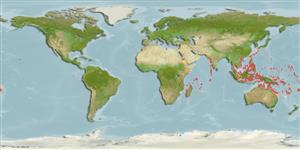>
Gobiiformes (Gobies) >
Gobiidae (Gobies) > Gobiinae
Etymology: Phyllogobius: Greek, phyhllon = leaf + Latin, gobius = gudgeon (Ref. 45335).
More on author: Smith.
Environment: milieu / climate zone / depth range / distribution range
Ökologie
seewasser riff-verbunden; tiefenbereich 2 - 18 m (Ref. 90102). Tropical
Western Indian Ocean: Mozambique. Western Central Pacific: Indonesia, Philippines, Solomon Islands, and the Great Barrier Reef.
Size / Gewicht / Alter
Maturity: Lm ? range ? - ? cm
Max length : 5.0 cm SL Männchen/unbestimmt; (Ref. 48637)
Kurzbeschreibung
Bestimmungsschlüssel | Morphologie | Morphometrie
Rückenflossenstacheln (insgesamt) : 7; Rückenflossenweichstrahlen (insgesamt) : 7 - 8; Afterflossenstacheln: 1; Afterflossenweichstrahlen: 8. Translucent, very finely dotted with red or black; two indistinct longitudinal rows of reddish dashes on back and one along lateral line; red line from upper lip to eye; a U-shaped reddish mark on each side of occiput behind eye (Ref. 27362). Caudal fin rounded (Ref. 27362); characterized further by having an extremely flattened head; unrestricted gill opening; unbranched 6-9 lowermost pectoral rays and thickened distally; longitudinal scale series 28-37; predorsal scales 10-13; depth of body at anus 5.1-9.4 in SL (Ref. 90102).
Inhabits coral reefs (Ref. 42915). Commensal on foliaceous flattened sponges (Phyllospongia) (Ref. 27362, 48637).
Life cycle and mating behavior
Geschlechtsreife | Fortpflanzung | Ablaichen | Eier | Fecundity | Larven
Randall, J.E., G.R. Allen and R.C. Steene, 1997. Fishes of the Great Barrier Reef and Coral Sea. Second Edition. Revised and expanded edition. Crawford House Publishing Pty Ltd. Bathurst, NSW, Australia. 557 p. (Ref. 27362)
IUCN Rote Liste Status (Ref. 130435: Version 2024-2)
Bedrohung für Menschen
Harmless
Nutzung durch Menschen
Tools
Zusatzinformationen
Download XML
Internet Quellen
Estimates based on models
Preferred temperature (Ref.
123201): 25.6 - 29.3, mean 28.4 °C (based on 1857 cells).
Phylogenetic diversity index (Ref.
82804): PD
50 = 1.0000 [Uniqueness, from 0.5 = low to 2.0 = high].
Bayesian length-weight: a=0.00724 (0.00339 - 0.01546), b=3.10 (2.92 - 3.28), in cm total length, based on LWR estimates for this (Sub)family-body shape (Ref.
93245).
Trophic level (Ref.
69278): 3.2 ±0.3 se; based on size and trophs of closest relatives
Widerstandsfähigkeit (Ref.
120179): hoch, Verdopplung der Population dauert weniger als 15 Monate. (Preliminary K or Fecundity.).
Fishing Vulnerability (Ref.
59153): Low vulnerability (10 of 100).
Nutrients (Ref.
124155): Calcium = 231 [100, 502] mg/100g; Iron = 0.995 [0.489, 1.990] mg/100g; Protein = 17.8 [15.8, 19.5] %; Omega3 = 0.0974 [, ] g/100g; Selenium = 22.6 [9.2, 56.1] μg/100g; VitaminA = 149 [37, 557] μg/100g; Zinc = 2.73 [1.69, 4.21] mg/100g (wet weight);
